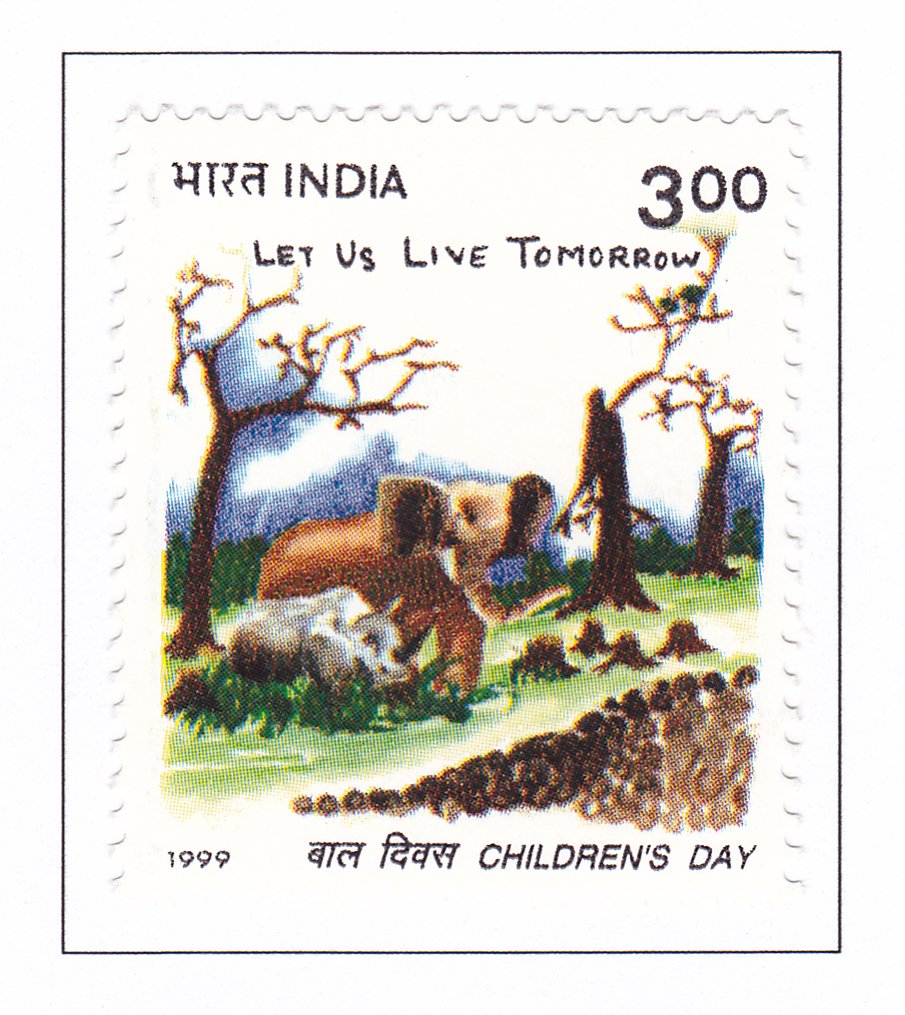Children’s Day 1999

Technical Data
| Stamp Set | Children's Day |
|---|---|
| Date of Issue | November 14, 1999 |
| Denomination | Rs. 3 |
| Quantity | 700,000 |
| Perforation | comb 14 |
| Printer | Security Printing Press, Nashik |
| Watermark | No Watermark |
| Colors | Multicolor |
| Catalog Codes |
Michel IN 1720 Stamp Number IN 1781 Yvert et Tellier IN 1487 Stanley Gibbons IN 1883 |
| Themes | Animals (Fauna) | Children | Elephants | Mammals | Paintings | Rhinoceroses |
Table of Contents
Commemorative Stamp for Children’s Day: 14th November
Design and Theme:
- Stamp Theme: “India 2000: Vision of the Future,” focusing on global peace, harmony, and the preservation of ecosystems as seen through the eyes of a child.
- Design Details: The stamp features a painting by Rishikesh Gohain, who won an award in the junior category of a nationwide Stamp Design Competition. The painting reflects a child’s vision of a harmonious and sustainable future.
- Message: “Let us live tomorrow,” emphasizing the importance of preserving the planet for future generations and promoting global peace and harmony.
Historical Context:
- Children’s Day: Celebrated annually on 14th November in India, this day underscores the country’s commitment to child welfare and the rights and needs of children.
- Constitutional Provisions: India’s dedication to child welfare is enshrined in its constitutional provisions and is guided by policies such as the National Policy for Children (1974).
- Past Themes: Previous Children’s Day stamps have highlighted various themes including nutrition, shelter, education, and empowerment of the girl child.
Significance:
- Millennium Issue: This stamp is part of the Millennium Issue, reflecting on the global concern for the environment and the future of the planet. The theme is inspired by ancient Indian scriptures, encapsulating the idea of a borderless world where all life forms coexist harmoniously.
- Educational Impact: The stamp serves as a reminder of the moral and social responsibilities toward children and emphasizes the need for sustained and coordinated efforts from all sectors of society.
- Youth Perspective: The stamp captures the simplicity and profundity of a child’s perspective, delivering a powerful message about the interconnectedness of life and the necessity of protecting the environment.
First Day Cover:
- Design: Features another award-winning entry by Kuhu Agrawal (Junior Category) on the same theme, providing an additional visual representation of the vision for the future.
- Purpose: The first day cover complements the stamp, offering further insight into the theme and showcasing the creativity of young artists.
Usage:
- Philatelic Collection: Ideal for collectors interested in stamps that reflect social issues, children’s rights, and environmental concerns.
- Educational Resource: Can be used in educational contexts to discuss global issues, environmental conservation, and the role of youth in shaping the future.
- Public Awareness: Highlights the collective responsibility to ensure a better world for children and underscores the importance of contributing to their well-being and development.
Overall Importance:
The stamp issued for Children’s Day serves as a powerful reminder of the need to safeguard the future of our planet and ensure a harmonious existence for all life forms. It encapsulates the vision of a child, symbolizing hope and the moral duty to provide a better world for future generations.
